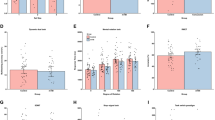Abstract
Generally, head-injured patients rate their functioning, as assessed by neuropsychological tests, less accurately than do informants. The current study, based upon a sample of 48 head-injured subjects, produced the following findings regarding this matter. There was no substantial agreement, as evaluated by the kappa coefficient, between patients and informants regarding status of memory, cognition, perceptual, and communicative skills. However, there was considerable agreement concerning status of motor function. The only consequential agreement between patients and neuropsychological tests was in the case of the Rivermead Behavioural Memory Test. There was substantial agreement between informants' ratings of complex abilities, with lesser agreement in the case of simpler skills. We concluded that the discrepancy in functional ratings among patients, informants, and test results diminishes when the tests being considered more closely resemble complex everyday activities.
Similar content being viewed by others
References
Acker, M. B. (1990). A review of the ecological validity of neuropsychological tests. In Tupper, D. E., and Cicerone, K. D. (eds.),The Neuropsychology of Everyday Life: Assessment and Basic Competencies, Kluwer Academic Press, Boston, pp. 19–55.
Babinski, M. (1914). Contribution of the study of mental disturbance in organic cerebral hemiplegia. (Anosognosia).Rev. Neurol. 12: 845–848.
Benton, A. L., Hamsher, K. deS., Varney, N. R., and Spreen, O. (1983). Contributions to Neuropsychological Assessment, Oxford University Press, New York.
Chelune, G. J., and Moehle, K. A. (1986). Neuropsychological assessment and everyday functioning. In Wedding, D., Horton, A. M., Jr., and Webster, J. (eds.),The Neuropsychology Handbook: Behavioral and Clinical Perspectives, Springer, New York, pp. 489–525.
Chelune, G. J., Heaton, R. K., and Lehman, R. A. W. (1986). Neuropsychological and personality correlates of patients' complaints of disability. In Goldstein, G., and Tarter, R. E. (eds.),Advances in Clinical Neuropsychology, Vol. 3, Plenum Press, New York, pp. 95–126.
Cohen, J. (1960). A coefficient of agreement for nominal scales.Educ. Psychol. Measure. 20: 37–46.
Crewe, N. M., and Athelstan, G. T. (1984).Functional Assessment Inventory Manual, University of Wisconsin-Stout, Menomonie.
Gainotti, G. (1972). Emotional behavior and hemispheric side of the brain.Cortex 8: 41–55.
Goldstein, G., McCue, M., Rogers, J., and Nussbaum, P. D. (1992). Diagnostic differences in memory test based predictions of functional capacity in the elderly.Neuropsychol. Rehab. 2: 307–317.
Heaton, R. K., and Pendleton, M. G. (1981). Use of neuropsychological tests to predict adult patients' everyday functioning.J. Consult. Clin. Psychol. 49: 807–821.
Hollingshead, A. B., and Redlich, F. C. (1958).Social Class and Mental Illness: A Community Study, John Wiley, New York.
Kaplan, E. F., Goodglass, H., and Weintraub, S. (1978).The Boston Naming Test, Lea & Febiger, Philadelphia.
Landis, J. R., and Koch, G. G. (1977). The measurement of observer agreement for categorical data.Biometrics 33: 159–174.
Mattis, S. (1988).DRS Dementia Rating Scale: Professional Manual, Psychological Assessment Resources, Odessa, FL.
Moran, L. J., and Mefferd, R. B., Jr. (1959). Repetitive Psychometric measures.Psychol. Rep. 5: 269–275.
Prigatano, G. P. (1987). Personality and psychosocial consequences after brain injury. In Meier, M. J., Benton, A. L., and Diller, L. (eds.),Neuropsychological Rehabilitation, Churchill-Livingstone, Edinburgh, pp. 355–378.
Prigatano, G. P., Altman, I. M., and O'Brein, K. P. (1990). Behavioral limitations that traumatic-brain-injured patients tend to underestimate.Clin. Neuropsychol. 4: 163–176.
Ranseen, J., Bohaska, L., and Schmitt, F. (1990). An investigation of anosognosia following traumatic head injury.Int. J. Clin. Neuropsychol. 12: 29–36.
Reitan, R. M., and Wolfson, D. (1993).The Halstead-Reitan Neuropsychological Test Battery: Theory and Clinical Interpretation, 2nd ed., Neuropsychology Press, Tucson.
Russell, E. W., Neuringer, C., and Goldstein, G. (1970).Assessment of Brain Damage: A Neuropsychological Key Approach, Wiley-Interscience, New York.
Smith, A. (1973).Symbol Digit Modalities Test Manual, Western Psychological Services, Los Angeles.
Wechsler, D. (1981).Manual for the Wechsler Adult Intelligence Scale — Revised, Psychological Corp., New York.
Wechsler, D. (1987).Manual for the Wechsler Memory Scale—Revised, Psychological Corp., New York.
Weinstein, E. A., and Kahn, R. L. (1955).Denial of Illness, C. C. Thomas, Springfield, IL.
Wilson, B., Cockburn, J., and Baddeley, A. (1985).The Rivermead Behavioural Memory Test Manual, Thames Valley Test, Reading, UK.
Author information
Authors and Affiliations
Rights and permissions
About this article
Cite this article
Goldstein, G., McCue, M. Differences between patient and informant functional outcome ratings in head-injured individuals. Int J Rehab Health 1, 25–35 (1995). https://doi.org/10.1007/BF02214959
Issue Date:
DOI: https://doi.org/10.1007/BF02214959




